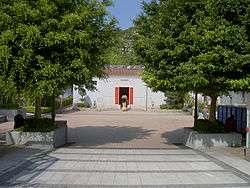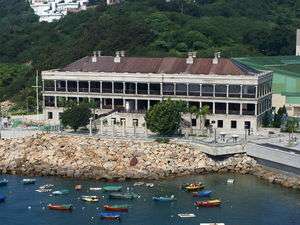Stanley, Hong Kong
| Stanley | |||||||||||||||||
 | |||||||||||||||||
| Chinese | 赤柱 | ||||||||||||||||
|---|---|---|---|---|---|---|---|---|---|---|---|---|---|---|---|---|---|
| Literal meaning |
"Bandit's post" or "red pillar" | ||||||||||||||||
| |||||||||||||||||
Stanley is a town and a tourist attraction in Hong Kong. It is located on a peninsula on Hong Kong Island. It is east of Repulse Bay and west of Shek O, adjacent to Chung Hom Kok. Administratively, it is part of the Southern District.
The Chinese name "Chek Chue" refers to the original village-town but "Stanley" generally refers to all the surrounding areas of the peninsula.
Name

There are two possible origins of the name "Chek Chue".
Legend has it that the notorious pirate Cheung Po Tsai was active in Stanley. That is why the district became known in Cantonese as Chak Chue (Chinese: 賊柱; literally: "Bandit's Post"). There was once a Cheung Po Tsai Cave near the Tin Hau Temple west of Stanley, but the cave was filled in the early 1950s.
The original Cantonese name of the village was believed to be based on a big tall cotton tree (Bombax malabaricum, Bombax ceiba 木棉樹) often covered with bright red blossoms at the time, hence red pillar (赤柱) in Hakka language.
It was given an English name after Lord Stanley (subsequently Earl of Derby), British Colonial Secretary at the time of the cession of Hong Kong to the United Kingdom, and subsequently Prime Minister.[1]
History
After the annexation of Hong Kong in 1842, the British made Stanley the temporary administrative centre, before moving it to the newly founded Victoria City (present day Central) on Hong Kong Island.
Stanley Fort was where British and Canadian troops mounted a last stand during the Battle of Hong Kong. The survivors surrendered to Japanese forces in December 1941. The fort, which was the former British Army barracks in Stanley, is now occupied by the People's Liberation Army following the transfer of sovereignty over Hong Kong to the People's Republic of China in 1997.
Places of interest
Stanley Market [2] and Pat Kan Uk


Stanley Market [3] is situated in Stanley New Street near the Stanley food market. It is an array of small shops and street stalls.
Pat Kan Uk is a row of eight houses. Many people think they are abandoned pre-war buildings but each of them is still a home to local elders. There were eight houses belonging to farming families in Wong Ma Kok before the Sino-Japanese War. The government recovered the land to develop barracks and a terrace of eight houses was built here as relocation homes for the local residents.
Stanley Main Street
Stanley has many bars and restaurants on its waterfront along Stanley Main Street.
To the west of Stanley Main Street, past the amphitheatre in Stanley Plaza is the Tin Hau Temple (Temple of the Queen of Heaven). Built by Cheung Po Tsai in 1767, it is one of the oldest temples in Hong Kong.
Murray House

Murray House is a Victorian-era building originally built in the present-day business district of Central in 1846 as officers' quarters of the Murray Barracks, the building was relocated to Stanley during the 2000s.
Stanley Plaza [4]
Adjacent to Murray House and Lung Tak Court, Stanley Plaza opened in 2001. It includes a shopping arcade and an outdoor community amphitheatre. The complex is owned by The Link REIT. Numerous free concerts and events are held in the amphitheatre throughout the year. In November 2011 Stanley Plaza reopened after a major renovation which was part of the transfer from government ownership to Link REIT ownership. A number of Asian and western restaurants, a good supermarket, Starbucks, Macdonald and a variety of shops can be found in Stanley Plaza. Well integrated with the Stanley Main Street waterfront and historic Murray House, Stanley Plaza provides convenient access to nearby tourist spots such as Tin Hau Temple and Stanley Ma Hang Park.
Stanley's beaches

Stanley is famous for its two beaches: Stanley Main Beach, located on the eastern side of the peninsular, and St. Stephen's Beach, on the western side. Both beaches are sandy and have areas designed for barbecues. Like many beaches in Hong Kong, they also have netted perimeters to protect swimmers from sharks.
The larger of the two beaches - Stanley Main Beach, which is also popular with windsurfers and other watersport enthusiasts, hosts the Stanley Dragon Boat Championships each year in June to celebrate the Tuen Ng Festival.
St. Stephen's College
St. Stephen's College is a primary and secondary school that has been located in Stanley for over 100 years. It has both day students and boarding facilities.
Originally a private school, St. Stephen's College became a government-funded public school during the late 1900s. The College recently announced its intention to become a Direct Subsidy Scheme (DSS) School, an historic change to the College as it will free the school from the centralised funding system that currently administers secondary education in Hong Kong. If the plan is widely accepted by students, parents and alumni, this new plan will be implemented during the 2008-2009 academic year. Pupils enrolled in the 2006 Primary 4 class at St. Stephen's College Preparatory School, also based in Stanley, will be the first group to enter the DSS system. In order to upgrade the school administrative level, this is the first secondary school in Hong Kong to employ a Registered Professional Housing Manager on its staff to manage and handle all property and facilities-related issues for and on behalf of the school.
Correctional Services Department (CSD) Complex

Stanley Prison is a maximum security level correctional facility, established in 1937, that houses the most hardened of criminals from the Hong Kong Judicial System. The Pak Sha Wan Correctional Institution (a medium security institution established in 1999) and the Tung Tau Correctional Institution (a minimum security institution established in 1982) are all part of the overall Hong Kong Correctional Services Department complex in Stanley. Nearby on Stanley Village Road is the Ma Hang Prison (a minimum security institution established in 1974) which houses male adult prisoners and clinically old prisoners of low security risk.
The CSD Staff Training Institute is also located in Stanley. It is responsible for planning and implementing training programmes to equip CSD staff with relevant knowledge.
The Correctional Services Museum is located at the entrance to the CSD complex in Stanley. It is open from 10:00 am to 5:00 pm daily except Mondays and public holidays. The Museum's collection has over 680 artefacts in nine galleries occupying some 480 square metres. Admission to the museum is free of charge.
Ma Hang Park

Stanley Ma Hang Park opened on 17 January 2011. The park has an area of 50,000 square-meters featuring various thematic zones to cater for people of all ages and interests. Pedestrian paths have been improved to enable safe and easy access to the various thematic zones, with display boards set up to introduce the birds, butterflies and plant species found in the park. Pak Tai Temple is also a part of the park. It was built in 1805 when Stanley was a major fishing village, and dedicated to the "protector of fishermen".[5]
Other areas of interest in Stanley

- The Hong Kong Sea School is located in Stanley.
- The Stanley Military Cemetery is located near St. Stephen's Beach.
- The Old Stanley Police Station, built in 1859 is a declared monument of Hong Kong.Today it retains the original architecture, but inside it houses a Wellcome Supermarket.
- Blake Pier at Stanley
- The Stanley Municipal Building opened in the summer of 2006. It houses some government offices, a medium-sized branch of the Hong Kong Public Library containing both English and Chinese books. It also houses several recreational rooms such as basketball and badminton courts. There is a very pleasant "garden zone" on the roof of the library section of the building with an outstanding view of Stanley Harbour.
- The Stanley Fort is a PLA military barracks located at the southernmost part of Stanley peninsula, south of the lighthouse. It is not open to tourists or to the public.
Public housing
Ma Hang Estate
Ma Hang Estate (Chinese: 馬坑邨) is a public housing estate in Stanley.[6] Formerly the site of Ma Hang Squatter Area, the estate is designed as "working village" and consists of 5 residential blocks completed between 1993 and 2000 for providing in-site rehousing for squatters.[7] Stanley Plaza,[8][9] Murray House and Blake Pier at Stanley are also the territories of Ma Hang Estate.
| Name | Type | Completion |
|---|---|---|
| Chun Ma House | Harmony Rural | 1993 |
| Kin Ma House | ||
| Koon Ma House | ||
| Leung Ma House | ||
| Ying Ma House | 2000 | |
Lung Yan Court
Lung Yan Court (Chinese: 龍欣苑) is a Home Ownership Scheme court in Stanley, next to Ma Hang Estate. Formerly the site of Ma Hang Squatter Area, the court has two blocks built in 1993.
| Name[11] | Type | Completion |
|---|---|---|
| Lung Chun House | Harmony Rural | 1993 |
| Lung Tan House | ||
The court was originally planned for rental housing, but it was converted to HOS court for sale finally. it consists of 4 blocks built in 2000.[12]
| Name[13] | Type | Completion |
|---|---|---|
| Chun Tak House | Harmony Rural | 2000 |
| Shing Tak House | ||
| Chi Tak House | ||
| Yi Tak House | ||
Transport
Stanley is served by several bus routes along Repulse Bay Road and Tai Tam Road. It is extremely easy to reach with several buses that go back and forth from all over Hong Kong, for example the bus routes 6, 6A, 6X, 66 and 260 (Citybus) from Central Exchange Square. In addition to the many bus routes, Stanley is also served by a taxi stand, which is often full of taxis awaiting customers. However, no MTR routes serve the Stanley area, nor there is currently a proposal for a line to serve this area.
Demographics
According to the Wall Street Journal, Stanley has a "a sizable French population".[14]
See also
References
- ↑ Yanne, Andrew; Heller, Gillis (2009). Signs of a Colonial Era. Hong Kong University Press. p. 30. ISBN 9789622099449.
- ↑ http://www.hk-stanley-market.com/
- ↑ http://www.discoverhongkong.com/eng/shop/where-to-shop/street-markets-and-shopping-streets/stanley-market.jsp
- ↑ http://www.stanleyplaza.com.hk/en/about_us/the_new_stanley_plaza.asp
- ↑ Stanley Ma Hang Park officially opened in Stanley (with photos) Government of Hong Kong. 17 January 2011.
- ↑ Southern District
- ↑ Ma Hang Estate
- ↑ Stanley Plaza
- ↑ Stanley Plaza
- ↑ Ma Hang Estate
- ↑ Lung Yan Court
- ↑ Lung Tak Court
- ↑ Lung Tak Court
- ↑ The Hottest Spot for French Expats These Days Is Hong Kong
External links
| Wikimedia Commons has media related to Stanley, Hong Kong. |
- Stanley Market, stantley Village,Murray house
- I Love Stanley - A Guide to Stanley
- Strolling Around Stanley Market
Coordinates: 22°13′N 114°13′E / 22.217°N 114.217°E